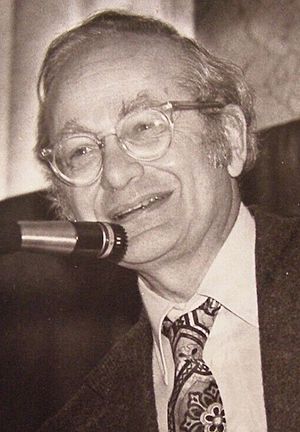David Hubel facts for kids
Quick facts for kids
David Hubel
|
|
|---|---|
 |
|
| Born |
David Hunter Hubel
February 27, 1926 Windsor, Ontario, Canada
|
| Died | September 22, 2013 (aged 87) |
| Nationality | American-Canadian |
| Alma mater | McGill University |
| Known for | Visual system |
| Spouse(s) |
Ruth Izzard
(m. 1953) |
| Awards |
|
| Scientific career | |
| Fields | Neurophysiologist |
| Institutions |
|
David Hunter Hubel FRS (February 27, 1926 – September 22, 2013) was a Canadian neurophysiologist noted for his studies of the structure and function of the visual cortex. He was co-recipient with Torsten Wiesel of the 1981 Nobel Prize in Physiology or Medicine (shared with Roger W. Sperry), for their discoveries concerning information processing in the visual system.
Contents
Career
For much of his career, Hubel was the John Franklin Enders University Professor of Neurobiology at Harvard Medical School. In 1978, Hubel and Wiesel were awarded the Louisa Gross Horwitz Prize from Columbia University. David Hunter Hubel (February 27, 1926 – September 22, 2013) was a Professor of Neurobiology Emeritus at Harvard Medical School.
Hubel was co-recipient with Torsten Wiesel of the 1981 Nobel Prize in Physiology or Medicine for their discoveries about information processing in the visual system. The prize was shared with Roger Sperry for his independent research on the cerebral hemispheres.
Hubel died of renal failure.
Nobel award
Hubel and Wiesel received the Nobel Prize for two major contributions:
- Their work in the 1960s and 1970s on how the visual system developed. They worked on parts of the visual cortex of the brain which get signals from the right or left eye.
- Their work describing how signals from the eye are processed by the brain to generate edge detectors, motion detectors, stereoscopic depth detectors and colour detectors. These are building blocks of the visual scene.
Some details
Cells detect features
In one experiment, done in 1959, they inserted a microelectrode into the primary visual cortex of an anesthetized cat. They then projected patterns of light and dark on a screen in front of the cat. They found that some neurons fired rapidly when presented with lines at one angle, while others responded best to another angle. Some of these neurons responded differently to light patterns than to dark patterns. Hubel and Wiesel called these neurons 'simple cells'.
Still other neurons, which they called 'complex cells', detected edges regardless of how they were placed in the visual field, and could detect motion in certain directions. These studies showed how the visual system constructs complex pictures of visual information from simple stimulus features.
Flexibility of visual cortex
They did important work in the study of cortical plasticity (flexibility).
By depriving kittens from using one eye, they showed that columns in the primary visual cortex receiving inputs from the other eye took over the areas that would normally receive input from the deprived eye.
These kittens did not develop areas receiving input from both eyes, a feature needed for binocular vision. Hubel and Wiesel's experiments showed that ocular dominance (dominance of one eye is normal) develops early in childhood development, and cannot be reversed. Several childhood vision problems were understood better after this work.
Related pages
Images for kids
See also
 In Spanish: David Hunter Hubel para niños
In Spanish: David Hunter Hubel para niños


